By Eric Niderost
Lieutenant-Admiral Michiel de Ruyter was a man of action, but he could be formidable even in repose On June 7, 1667, de Ruyter was sitting in the great cabin of the Dutch flagship Harderwijk listening stolidly while Cornelius de Witt finally revealed his plans for a raid on England to a group of assembled naval officers. De Witt was the brother of Grand Pensionary (chief of state) Johan de Witt, so his words carried a great deal of weight. When the expedition left the Netherlands, the commanders had been purposely left in the dark, for reasons of secrecy. Now all would be revealed.
De Witt read the secret orders, and though they were technically written in the name of the Estates General, the mastermind of the plan was de Witt himself. The proposal was so bold and daring that it left many of the Dutch mariners astounded. They were to sail into the Thames estuary, enter the Medway River, and proceed to the great dock at Chatham, where many of England’s proudest warships were laid up. Once they arrived at their objective, the raiders were to sink or burn as many ships as they could, taking care to carry off the best ships as prizes. Such a raid would strike a heavy blow to England’s power and prestige, since the Royal Navy was the island nation’s pride. Chastised and humbled by defeat, the English might accept a peace on Dutch terms.
It was a plan that was easy to write down on paper but formidable to execute on the high seas. The Thames estuary was full of treacherous currents and dangerous sandbars, notoriously tricky to navigate. In addition, the English had several forts in the area, and the entrance to the Medway was bound to be patrolled by guard ships that would bar their way. The Medway was governed by the ebb and flow of tides from the Thames estuary, which necessarily meant that Dutch progress to Chatham would be very slow—perhaps lasting days. While the Dutch struggled up the Medway, the English would be given time to mount an adequate defense.
The Dutch officers who listened to de Witt raised all these objections, loudly expressing their doubts in no uncertain terms. It seemed foolhardy, even suicidal, to strike so deeply into enemy territory, the officers objected. De Witt looked at de Ruyter, and it was plain by his expression that he, too, had doubts about the operation. De Ruyter was the greatest living Dutch admiral, a man respected and loved by his men, who had given him the nickname Bestevaer, or Grandfather, in token of their affection. If he accepted the mission, however reluctantly, the others would go along. The admiral, a stocky man with thick jowls and a slightly upturned mustache, decided to give his blessing to the plan. “Orders are orders,” he declared flatly. The other officers were suitably influenced by de Rutyer’s no-nonsense approach to the situation. By the next day, most of them were positively enthusiastic about the enterprise. The great Medway raid would proceed on schedule.
The Beginnings of the Second Anglo-Dutch War
The Medway raid was the climax of what historians would come to know as the Second Anglo-Dutch War. The First Anglo-Dutch War, which took place from 1652 to 1654, ended in an English triumph. For the next decade, there was an uneasy peace, but it was only a matter of time before England and the Netherlands would be at war again. The Anglo-Dutch conflicts were rooted in the ever-growing commercial rivalry between two great maritime nations whose prosperity was founded on trade and territorial expansion. The Dutch insisted on the right to trade with anyone, free of any restrictions, yet they jealously guarded their own colonies and excluded outsiders. The English coveted Dutch trade routes and colonies, while the Dutch rightly looked on the English as ruthless business competitors.
England’s King Charles II genuinely appreciated the way the Dutch had given him refuge during his exile in the 1650s, but he was not about to let personal sentiment interfere with national interests. His brother James, Duke of York, and a number of other nobles had founded the Royal African Company to exploit the riches of the great continent, knowing that they would be clashing head-on with Dutch interests already established there. In 1664, the Royal African Company boldly captured the Dutch colonies and trading posts along the African coast, even though the two nations were technically at peace. The English also seized New Amsterdam in America, which had long been a thorn in the side of their own colonial ambitions. They renamed the colony New York. These aggressive acts moved the English and Dutch ever closer to war.
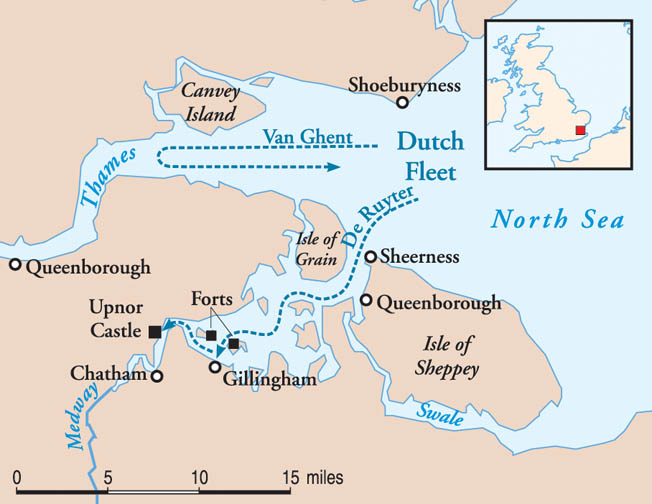
The Dutch finally decided to act, dispatching de Ruyter to Africa to retake what the English had so impudently stolen. The English public clamored for war, their passions stoked by a steady stream of scurrilous anti-Dutch broadsides and pamphlets. Not all English grievances were trumped up. In 1623, a group of English traders had been tortured and killed by Dutch troops on Amboina in the Spice Islands (now Indonesia). The Dutch government later apologized for the massacre and offered compensation to survivors, but many Englishmen still hungered for revenge. Charles II heeded the bellicose mood that was sweeping the country and declared war on the Netherlands in May 1665.
British Troubles on the Homefront
The Second Anglo-Dutch War was going to prove different from the first conflict. At first, the Royal Navy garnered fresh laurels at the Battle of Lowestoft, just off the English coast. The Duke of York’s fleet administered a crushing defeat on the Dutch, who lost 30 ships, 5,000 men, and three full admirals. But sometimes history can be altered by trivial events. James went to bed early, and his aides were made of less stern stuff. They vacillated when they should have ordered a pursuit of the Dutch fleet’s broken remnants. The opportunity for total victory was lost, and the Dutch were allowed to lick their wounds and live to fight another day.
As the months went on, England was distracted by a series of unprecedented disasters. The first occurred in the summer of 1665 when bubonic plague, the dreaded Black Death of the Middle Ages, returned with a vengeance. The wealthy escaped to the countryside, while the poor died in droves in London, the pestilential city. By the time the plague finally abated, nearly 100,000 Londoners—perhaps one-quarter of the population—had succumbed. Noted diarist Samuel Pepys observed that he could walk down normally busy Lombard Street and not meet 20 people along the way. Church bells rang incessantly for the dead.
London had hardly recovered from one disaster when it fell victim to another. In the summer of 1666, a huge fire started by sparks from a bakery blowing onto the thatched roof of a nearby inn lasted four days and consumed a good part of the city. When it was over, some 4,000 Londoners were dead and 13,000 houses, churches, libraries, and hospitals were in ashes. “You would have thought that it had been Doomsday,” said a stunned survivor. In retrospect, the fire helped to create a relatively cleaner, healthier—at least by 17th-century standards—capital city, but in the short run it was a disaster, “a most horrid, malicious, bloody flame,” Pepys called it.
The year 1666 was also a mixed blessing on the war front. The Royal Navy gave a good account of itself in the celebrated Four Days’ Battle that June, but the English line was broken by the Dutch under de Ruyter and they were forced to withdraw. Charles II had famously declared that “it is upon the navy that the safety, honor, and welfare of the realm chiefly depend.” Few Englishmen would dispute that statement, but Parliament was reluctant to give the Navy the funds it desperately needed to survive. It was literally a “penny wise, pound foolish” policy that ultimately led to maritime disaster. All agreed on the necessity of a navy, but no one wanted to pay for it. The Navy could barely meet its expenses, yet most Englishmen resented the excise taxes levied to support the fleet
A Crooked Naval Administration
The Royal Navy’s funding problems, though acute, were only part of the story. The Navy Board was responsible for the building and repair of Royal Navy ships, as well as keeping them adequately supplied. But the naval administration was notoriously corrupt, even by the loose standards of the 17th century. Contractors often overcharged the government and supplied inferior goods. Bribery and rigged contracts were commonplace, and naval supplies—even heavy ordnance—were stolen and resold. In the early years of the king’s reign, naval commissions were purchased by the gentry, many of whom had little or no experience of the sea. But it was the common sailor who suffered most of all. Living conditions aboard English ships were Spartan at best, appalling at worst. Food—what there was of it—grew moldy and weevil-infested. Water quickly went bad, and the lack of fresh vegetables led to scurvy. Many of the men were pressed, or forced, to serve in the Navy by being virtually kidnapped off the street. Pepys, who was clerk of the acts for the Navy Board, detested the practice, considering it “a great tyranny,” but it continued unabated.
But even the most willing mariners found life hard, especially when they were not paid for years. “Keep the pay, keep the man,” sailors said derisively. The government tried to fix the problem by issuing “tickets,” promissory coupons that were supposed to be legal tender. After a time, most merchants refused to accept them. Naval families became destitute, and some experienced real starvation. Mariners were understandably bitter about how they were being treated, becoming reluctant to risk their lives in the service of so stingy a government. Morale plummeted, and men deserted at the first opportunity. Not all naval administrators were greedy or incompetent. Pepys, now known mainly for his famous diary, which vividly details both the events of the day and his numerous amorous affairs, was a patriotic, hard-working man who did his best to help introduce badly needed reforms and regulate accounting procedures to reduce corruption. But actual reform took years to achieve, and England was about to face a more immediate crisis.
In the spring of 1667, King Charles II found that funds allocated for the Navy were quickly drying up. There was simply no money to maintain the fleet at its current levels, much less expand it for war operations. The king could have negotiated with Parliament, but he was reluctant to do so. The lawmakers might want to reduce the royal prerogative and weaken his powers as England’s monarch. (A generation earlier, the lawmakers had certainly weakened his father’s powers, chopping off his head and instituting a short-lived commonwealth under Puritan leader Oliver Cromwell.) The great fire of London had also devastated the English business community, a chief source of funds. The only alternative was to reduce the Royal Navy by laying up most of the capital ships, mothballing them at the Chatham dockyard in Kent until funds might become available again. Crews, which numbered in the hundreds on larger vessels, would be reduced or dismissed entirely. Little thought was given to the possibility of a Dutch invasion.
Attempts at Peace, Alarms at Chatham
The king began a series of peace negotiations with the Dutch at Breda, which further reinforced English complacency. The English did not think that the Dutch would attack while meetings were in progress. Charles also forged a secret connection with Louis XIV, the powerful king of France. He hoped that French pressure might make the Dutch think twice about any offensive action.
In the meantime, reports coming out of Holland indicated that a large Dutch fleet had recently set sail, destination unknown. This news prompted Charles to issue an order to the lord lieutenants of the maritime counties of the eastern and southeastern coasts to put their militias on full alert. On June 6, the Duke of York ordered the Navy Board to issue an alarm to the dockyard at Chatham. As the country’s premier dockyard and shipbuilding facility, Chatham was vital to the nation’s defense. In charge of the dockyard was Resident Commissioner Peter Pett, a man whose father, Phineas, had designed and built many of England’s finest vessels. Upon hearing the warning, Pett ordered that “all persons in this river [Medway] strictly look to their duties.” Admirable sentiments, but Pett seems not to have done much for the next three days. On June 9, 30 Dutch ships were spotted in the Thames estuary. There was a distinct and ever-growing possibility that the raiders were headed for Chatham. Pett immediately sent a letter to the Navy Board lamenting the fact that he had no senior officers to assist him in the defense.
The next day, King Charles ordered George Monck, Duke of Albemarle, to go to Chatham and organize the defenses there. Albemarle was an old soldier, someone who would not be prone to panic (as Pett seemed to be). This was fortunate, because widespread unease, if not absolute panic, had begun to sweep the country. Pepys, going down the Thames to Gravesend, encountered many refugee boats hurriedly sailing in the opposite direction. As he put it, “I met several vessels in my going down, loaded with the goods of the people of Gravesend. Such was their fright.” Sailors’ wives marched the streets crying, “This comes of your not paying our husbands; now your work is undone.”
An Impressive Dutch Navy
Although wild rumors probably inflated its danger, the Dutch fleet was certainly formidable. There were 62 ships of the line, or frigates, about 15 smaller ships, and about a dozen fireships, vessels that were deliberately set ablaze and cast loose in the enemy’s direction. Fire was a great danger in the age of wooden ships, and the presence of a fireship could cause great havoc in an enemy battle line. The Dutch raiding fleet was organized into three squadrons. The first was commanded by de Ruyter, the second by Lieutenant-Admiral Aert Jenesse van Nes, and the third by Lieutenant-Admiral Baron Willem Joseph van Ghent.
Although de Ruyter’s fame overshadowed him, van Ghent was the real mastermind of the operation. It was he who did all the operational planning, which included landings by Dutch marines. The Dutch marines were the first in early modern European history to be used in amphibious operations. Van Ghent had once commanded them, but during the Medway raid they were under an English renegade named Colonel Dolman. Once ashore, they would attack enemy positions and seize enemy goods. Dolman was not the only turncoat in the expedition. In fact, there were a number of English sailors aboard the Dutch ships, ready and willing to pilot the raiders though the treacherous sandbars and shoals. It was said that during the raid English voices were heard on Dutch ships, gleefully crying, “We did heretofore fight for tickets; now we fight for dollars!” The English government’s short-sighted fiscal policies were bearing bitter fruit.
The third Dutch squadron under Admiral van Ghent arrived off Sheerness around noon on Monday, June 10. Sheerness is located on Sheppey Isle, a small island just off the mouth of the Medway as the river enters the Thames estuary. Sheerness was home to a new fort that commanded an excellent view of the river mouth. Unfortunately, it was only half built. According to one story, angry workmen had deliberately walked off the job because they had not been paid. The overall defense of Sheerness had been entrusted to Sir Edward Spragge, a doughty old soldier of proven ability. But Spragge had little to work with—just the partially built fort, the frigate Unity, and a handful of ketches and fireships. The garrison was also unreliable and able to bolt at a moment’s notice. The Sheerness fort boasted 16 cannons, but they had been poorly mounted on soft soil. When they discharged, their carriages were driven into the ground, rendering them incapable of further use. As a stopgap solution, some wooden planks had been hastily thrust under the carriages to take the recoil.
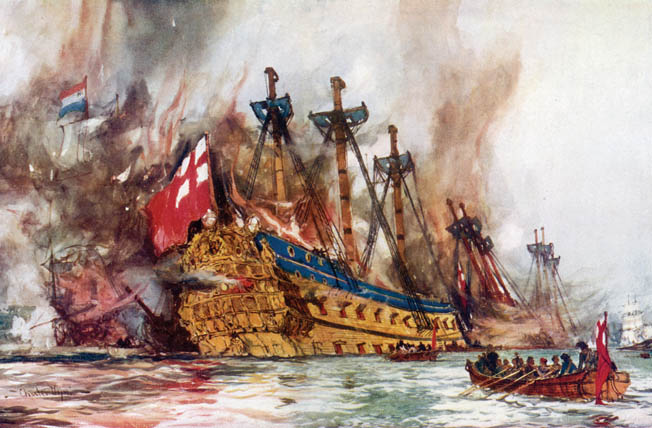
The Attack Begins
The Dutch decided to attack about 5 o’clock that afternoon. Captain Jan van Braakel in Vrede was to lead the assault, accompanied by two other warships. Van Braakel was to bombard the fort after sailing as close to shore as he could. Once he opened the attack, the rest of the squadron was to follow in quick succession, pounding the English fort into rubble. While the British were occupied with this artillery duel, Dutch marines would be put ashore to take the fort by land. As he engaged the fort, van Braakel noticed that Unity, and some English fireships and ketches were positioned nearby. Unity fired a broadside at the approaching Dutch, who responded by launching a blazing fireship of their own.
Unity saw the blazing hulk bearing down on her and quickly decided that discretion was the better part of valor. Unity beat a hasty retreat up the Medway, the English fireships and ketches following close behind. Sheerness Fort was on its own. Dutch cannons pummeled the fort, pockmarking its half-finished masonry with a steady hail of iron shot. One Englishman was killed outright, severely unnerving the gun crews. A cannonball smashed into another man, tearing off his leg and thigh. Blood poured from the jagged wound, spreading gore all over the parapet as the other gunners looked on in horror. A rumor went through the ranks like wildfire—there was no surgeon available; anyone who was wounded would surely die. This idle rumor triggered a stampede, in which all but seven men took to their heels. The brave seven remained at their posts, working the guns as best they could, but it was clear the fort would soon fall. Around 800 Dutch marines under the renegade Colonel Dorman landed about a mile away without opposition. The loyal seven were forced to abandon their posts, leaving Sheerness Fort to the enemy.
Taking Sheerness Fort
A small party of Dutch seamen was the first to actually enter Sheerness Fort. Captain Cornelis Gerrits Vos, master of the yacht Jonge Prinz, launched a longboat and landed well before the marines arrived. One of his first acts was to haul down the British Union flag and replace it with the Dutch colors. (Vos later received 100 ducats from the Admiralty of the Maas for his courage and initiative.) The raiders were gratified by their victory, made sweeter by the enormous amount of valuable stores they found within the fort. There was sawn timber, masts, spars, stockpiles of iron and brass, and barrels of gunpowder, resin, and tar—the latter two items crucial in shipbuilding and maintenance. The stores were removed as booty, and the fort’s guns were taken as well. As a final vengeful measure, the fort itself was demolished. The previous year, an English raiding force had landed on the Dutch island of Terschelling and disgraced themselves by burning and looting the fishermen’s houses they found there. It was an incident that would long be remembered by the Dutch, who were at pains to prove that they were more civilized than their island enemies. For that reason, strict orders were given for the Dutch sailors and marines to refrain from looting.
For some Dutch crew members of Vrede, the temptation was too great, and the sailors plundered the deserted homes, bringing back all the booty they could carry. In fairness to the Dutch, the looting at Sheerness was the only black mark in a raid that generally respected private property. It was said that some Scottish and English troops, ostensibly sent to protect lives and property, did more looting than the enemy. In the meantime, the Duke of Albemarle had his hands full organizing an adequate defense. He arrived at Gravesend accompanied by a swarm of courtiers whom Pepys viewed with a certain middle-class contempt. To Pepys, there were “a great many idle lords and gentlemen with their pistols and fooleries.” When Albemarle arrived at Chatham in the early morning hours of Tuesday, June 11, he found the dockyard in a considerable state of disarray.
Advancing up the Medway River
Panic was sweeping Chatham, and of 800 dockworkers only a dozen men still remained. Albemarle found the remainder “so distracted by fear, that I could have little or no service from them.” There were few boats available to transport troops or to tow the large warships that lay at Chatham. Chatham’s last remaining defense was an 800-yard iron chain with six-inch links that stretched across the river at Gillingham. The chain was suspended on floating platforms and operated by pulleys, but the sheer weight of the chain caused it to dip below the waterline some nine feet. It was feared that shallow-draft Dutch ships might slip across it across unimpeded, so the ponderous links had to be readjusted.
Two guardships, Charles V and Matthias, were positioned above the chain to bring their broadsides against any Dutch ship that attempted to cross over. Monmouth, with 66 guns, was moored in such a way as to bring her guns to bear in the gap between the other two ships’ fields of fire. Unity, which provided additional firepower, was stationed below the chain. In the meantime, de Witt and van Ghent decided to push on to Chatham. Everyone was in high spirits; the raid was succeeding beyond all expectations. More than a dozen English vessels were moored at Chatham, including some of the proudest ships in the Royal Navy. The most tempting prize was Royal Charles, a 1,250-ton, three-decker ship that had carried King Charles back from exile in 1660. She had been the English flagship in several ensuing naval battles and was the very symbol of Britannia’s mastery of the seas.
It was decided that Captain Thomas Tobiaz, an Irishman in Dutch service, would lead an advance party up the Medway River. This party would consist of three frigates, four armed yachts, and two fireships. The rest of the squadron would follow closely. Tobiaz left Sheerness about 6 am on Wednesday, June 12. The entire Dutch force was strung out in a single-file, line-astern formation, in part because of the narrowness of the river. As yet, there was no serious opposition to the raiders. The British Army was in embryonic form. Parliament distrusted standing armies as possible instruments of royal tyranny, and kept a wary eye on any attempts to expand it. There were few truly professional regiments, and those that did exist were mainly part of the king’s household troops such as the Lord General’s Regiment of Foot Guards, later the Coldstream Guards. These professional soldiers were scattered about the country. In their place, a heavy reliance fell on the county militias, few of which could be counted on to stand up in a real confrontation.
The Dutch progress up the Medway was slow but steady, but soon they found themselves blocked by the Gillingham chain. While van Ghent and de Witt debated what to do next, they received an unexpected offer by Captain Jan van Braakel, master of Vrede. Van Braakel was under something of a cloud because he had allowed his men to forage and loot on Sheppey Isle. He had been put under arrest, and now was confined to the Agatha. Chafing under close confinement and eager to redeem himself, van Braakel offered to use Vrede as a kind of decoy to draw English cannon fire. He would sail toward the chain first, allowing the two Dutch fireships to come behind him and lend support. De Witt and Van Ghent reluctantly agreed—there seemed to be little alternative.
Capturing Unity, Continuing the Advance
Once van Braakel was aboard Vrede, he got under way at once. The English guardships commenced firing, supported by shore batteries that had been hastily put in place a day or two before. Vrede weathered the iron gauntlet, but one more obstacle remained before reaching the chain—the 44-gun Unity. Instead of slugging it out with the English ship, van Braakel did the unexpected—he came alongside and boarded her. Unity was crewed by 150 men, but most of them were civilians—Thames watermen who had been pressed into service and scarcely knew one end of a sword or pike from the other. It was debatable if they even knew how to serve the cannons, and there was little artillery fire from the unlucky ship. As soon as the first Dutchman set foot on Unity, the crew took to their heels. A few were captured; the rest made good their escape. Vrede suffered light casualties. Three men were wounded and one subsequently died.
While Vrede was busy with Unity, the Dutch fireship Susanna sailed up to the chain but failed to break it. Minutes later, she was completely consumed in flames and out of action. A second fireship, Pro Patria, took her turn and was more successful. Pro Patria broke through the iron links, clearing the way for the Dutch to proceed to Chatham. Pro Patria sailed on, positioning herself alongside the English guardship Matthias, which was anchored just above the now-broken chain. The Dutch fireship set Matthias alight, and within minutes the ship was a raging inferno from stem to stern. Matthias blew up with a deafening roar, great gouts of smoke and flame spreading blackened debris far and wide. A third fireship, Delft, tried to get near the Charles V, but the latter’s well-served guns sank her before she could get too near. The Dutch persisted, and a fourth fireship finally managed to get Charles V into her fiery embrace. Some of the English crew fled, but others stayed on. Van Braakel came alongside with a boarding party, and the sight of the fierce Dutch officer approaching with sword drawn compelled the rest of the crew to surrender.
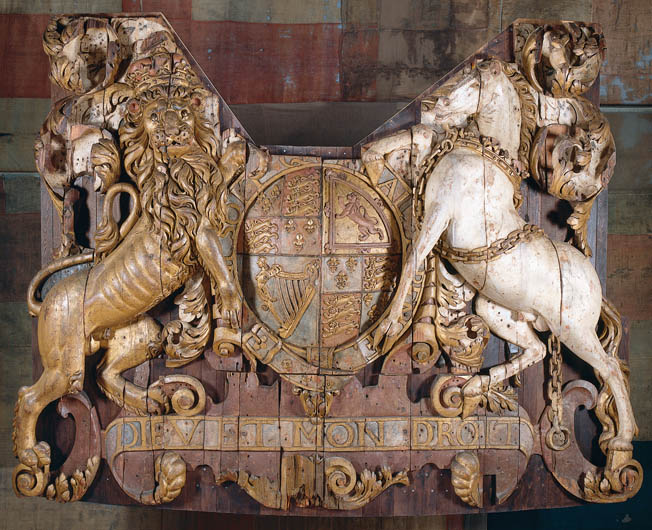
After accepting their capitulation, van Braakel ordered his trumpeter to go aloft and haul down the English flag. This was a calamitous turn of events, but England’s humiliation was just beginning. The Dutch tried to put out the fires on Charles V, but eventually they were forced to abandon the vessel. A short time later the ship blew up. Monmouth, seeing the destruction of her two sister guardships, decided that it was high time to leave the scene. Longboats towed the great ship up the river and out of harm’s way. The sad events were witnessed by Lord Brouncker, Sir John Mennes, and Peter Pett from a barge a safe distance away. They managed to dispatch boats to pick up survivors in the water but could do little else to rally the English defenders.
“On Pain of Death”
The greatest prize of all, Royal Charles, was just a short distance from the broken chain and well within reach of the Dutch raiders. The great ship was only half rigged and had only 32 of her normal complement of 80 guns. She had a skeleton crew, and the handful of sailors managed to provide some reinforcement after they were told to rush to the ship “on pain of death.” The raid was at its height. Historian William Laird Clowes described the scene in vivid prose: “The river was full of moving crafts and burning wreckage; the roar of guns was almost continuous; the shrieks of the wounded could be heard even over the noise of battle, the clangor of trumpets, the roll of drums, and the cheers of the Dutch as success after success was won. Above all hung a pall of smoke, illuminated only, as night closed in, by the gleam of flames on all sides and the flashes of guns and muskets.”
When the Dutch approached Royal Charles, her crew abandoned ship without hesitation. In fairness to the seamen, they had few if any arms to fight with, and their morale was low after seeing the debacle at the chain. A boarding party of only nine Dutchmen took possession of England’s proudest vessel. Cornelis de Witt wrote a glowing report to the Estates-General detailing the victory, penning the missive in the admiral’s cabin aboard Royal Charles—the very place where the Duke of York had directed successful operations against the Netherlands during the Four Days’ Battle. Now the tables were turned.
Three More Prizes
By late Wednesday the tide ebbed, halting further Dutch progress up the river. There were still some tempting prizes ahead: Royal Oak, Loyal London, and Royal James. De Ruyter came up the Medway and conferred with van Ghent and de Witt as to the next course of action. It was decided that four warships and three armed yachts should sail up the river and engage Upnor Castle, a Tudor-era fortification that guarded Chatham. While Upnor was being kept busy, five fireships would slip past and get alongside Royal Oak, Loyal London, and Royal James in an effort to set them ablaze. The attempt would begin the next day.
The Duke of Albemarle had placed Sir Edward Scott, a reliable man, in charge of Upnor Castle. Provisions were sent to the castle, along with reinforcements in the form of an extra company of soldiers. The extra troops would make sure that any landing by Dutch marines, as at Sheerness, would be repulsed. Sixteen more ships were ordered scuttled by Albemarle to prevent their capture. Some 30 ships were sunk by the English themselves, which prompted a satirist to write: “Of all our navy none should now survive./But that the ships themselves were taught to dive.”
Albemarle’s chief worry was the all-important dockyard and the new dockyard a little farther up the river. These facilities were crucial if England was to maintain its position as a major maritime power. If they were destroyed, it would be a crippling blow to the country’s power and prestige. Luckily for the English, 10 large guns from the Tower of London arrived on the scene and were mounted in a nearby field overlooking the new dockyard. Another 50 cannons were placed in various positions where they could be trained on any Dutch ship attempting to come upriver. The Dutch would get a warm welcome. Albemarle spent all night on the arrangements, making the rounds to provide encouragement to his men. The Chatham defenders seem to have been made of sterner stuff. It was clear that the Dutch were about to face their first really serious opposition. As the Duke later recalled, “I stayed all night on the place by the men, and having no money to pay them, all I could do or say was little enough for their encouragement, for I had no assistance from Commissioner Pett.”
The Dutch made their move around noon on Thursday, June 13. They moved forward in good style, but then the favorable northeast wind started to die down, stalling the effort. The wind did not pick up again until around 2 pm, and by that time the leading Dutch ships were well within range of Upnor Castle and the surrounding shore batteries. This time, the Dutch were not going to be unscathed. English gunfire was heavy, a rain of cannonballs that smashed into wooden bulkheads and killed and wounded several Dutch sailors. Nevertheless, the fireships managed to approach Loyal London, Royal Oak, and Royal James, which had been grounded in shallow water. Enough of their upper works remained above the waterline to catch fire.
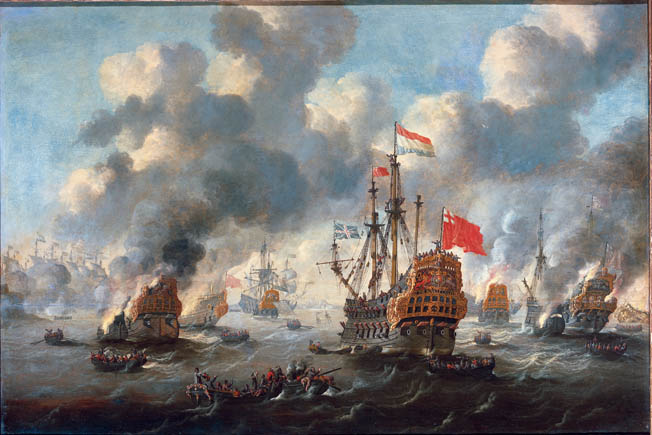
“The Dutch Have the Best of Us”
The Medway River was narrower here than at the chain, and the fighting was even more intense. The shore was thick with English cannons, their combined discharges creating an ear-splitting roar that could be heard for miles. The Dutch replied as best they could, but for once the sheer weight of metal seemed to be on the English side. The English fought bravely, but it was now the courage of despair. All knew in their hearts that they were witnessing a great humiliation, the greatest naval defeat the island nation ever experienced. De Ruyter was in his element, directing operations in an open rowboat under heavy fire and swinging a cutlass over his head.
Royal Oak had a contingent of Scots soldiers under Captain Archibald Douglas. When the great ship was burning, the heat grew so intense that the soldiers were forced to abandon ship. Douglas refused, remaining at his post until consumed by the flames. There was no real reason for Douglas to sacrifice himself in that way, but his suicidal act was considered by many to have at least partly redeemed the country’s honor. He, at least, did not run away.
The fighting slackened as the three vessels burned fiercely. The Dutch decided to quit while they were ahead. The dockyards were a tempting target, but English resistance was fierce, and the river was growing ever narrower. The triumphant raiders withdrew, navigating the treacherous, shallow river with some difficulty. When they reached the safety of the open sea they celebrated by firing their cannons. Samuel Pepys, ever the realist, concluded: “Thus, in all things, in wisdom, courage, force, knowledge of our own streams, and success, the Dutch have the best of us, and do end the war with victory on their side.”
Aftermath of the Great Medway Raid
The Great Medway Raid was over. Four capital ships had been lost, and many smaller vessels had been sunk or otherwise damaged. The total loss for the Royal Navy was estimated at close to 200,000 pounds. The English could take comfort only in the fact that the dock facilities were still intact. Peace negotiations accelerated, and the war ended formally in July 1667. The two countries divided the world into colonial spheres of influence. The Dutch took the East Indies, while the English contented themselves with their holdings in North America.
Charles II took the defeat personally. Chatham’s ill-starred naval commissioner, Peter Pett, was hauled before an examining committee and made to answer for his—and many others’—mistakes. Pett, “a weak, silly man” in Pepys’ view, was a convenient scapegoat. In short order, he was bundled off to the Tower of London. Four months later, after peace was restored, he was released into personal and professional oblivion. Meanwhile, Royal Charles was towed back to Holland and exhibited as a kind of 17th-century tourist attraction. The ship had too deep a draft to be used in the shallow waters of the Netherlands, and after a few years of display, she was scrapped. The stern’s royal coat of arms was saved and now rests in the Rijksmuseum in Amsterdam.
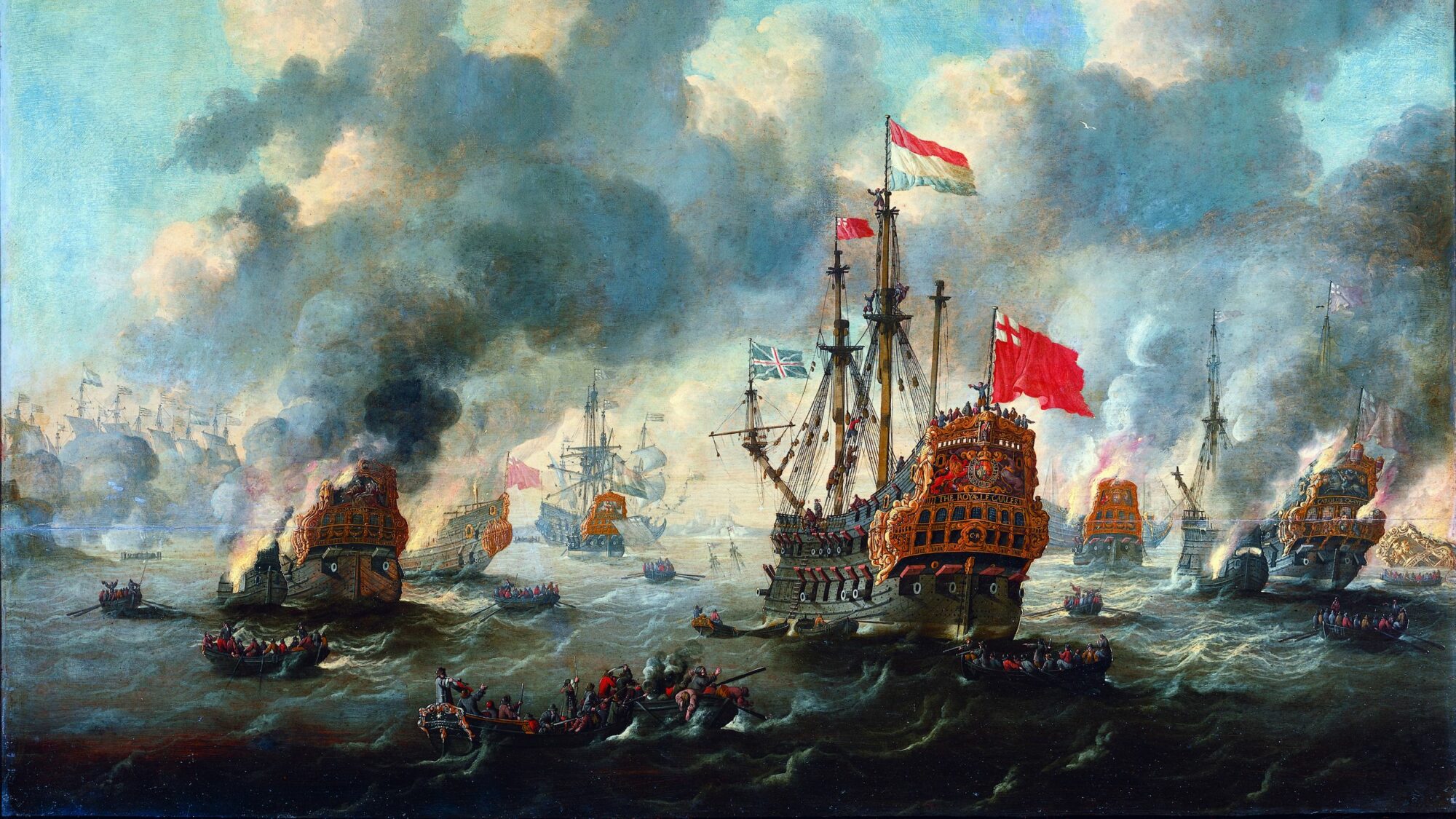

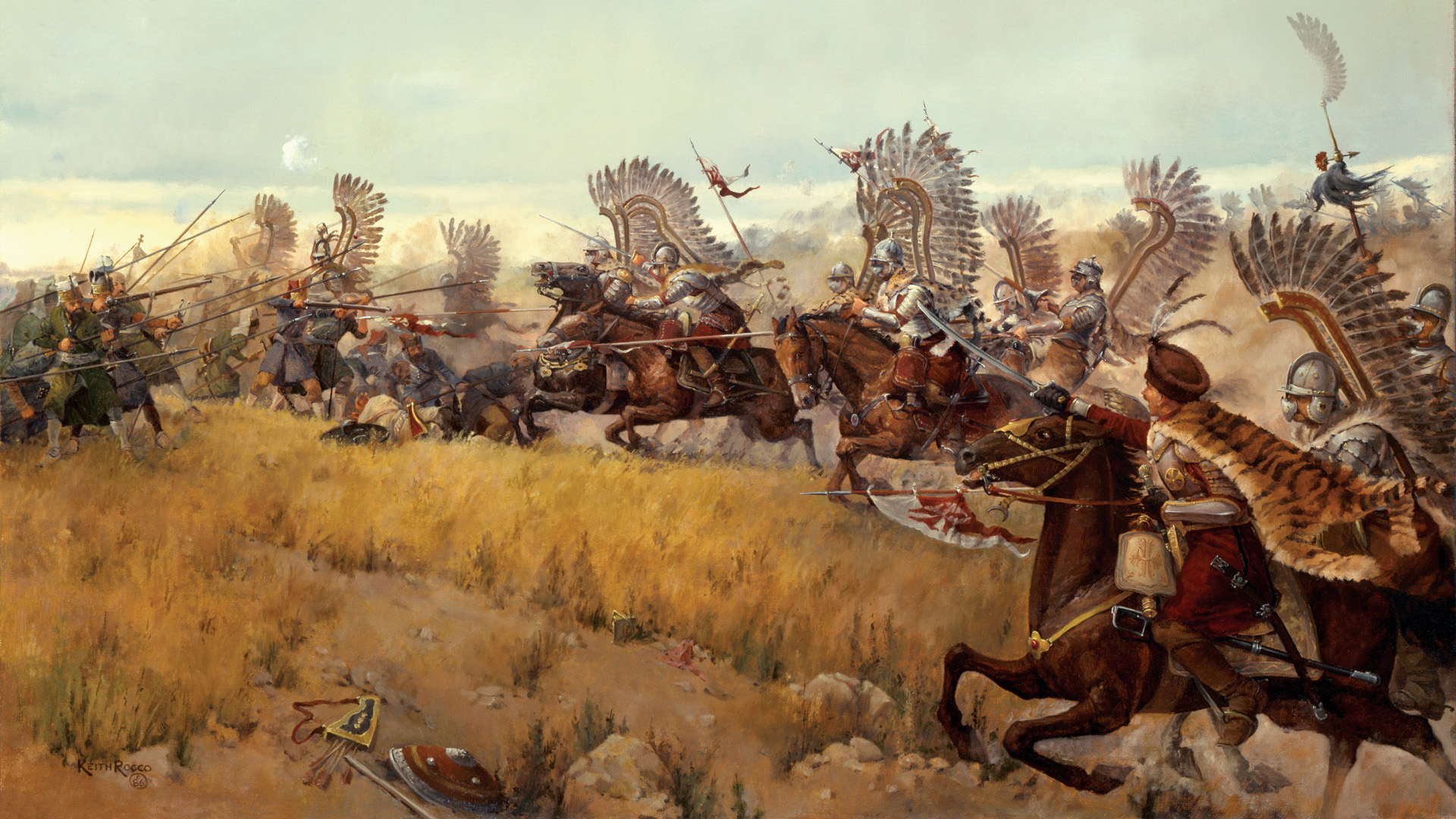
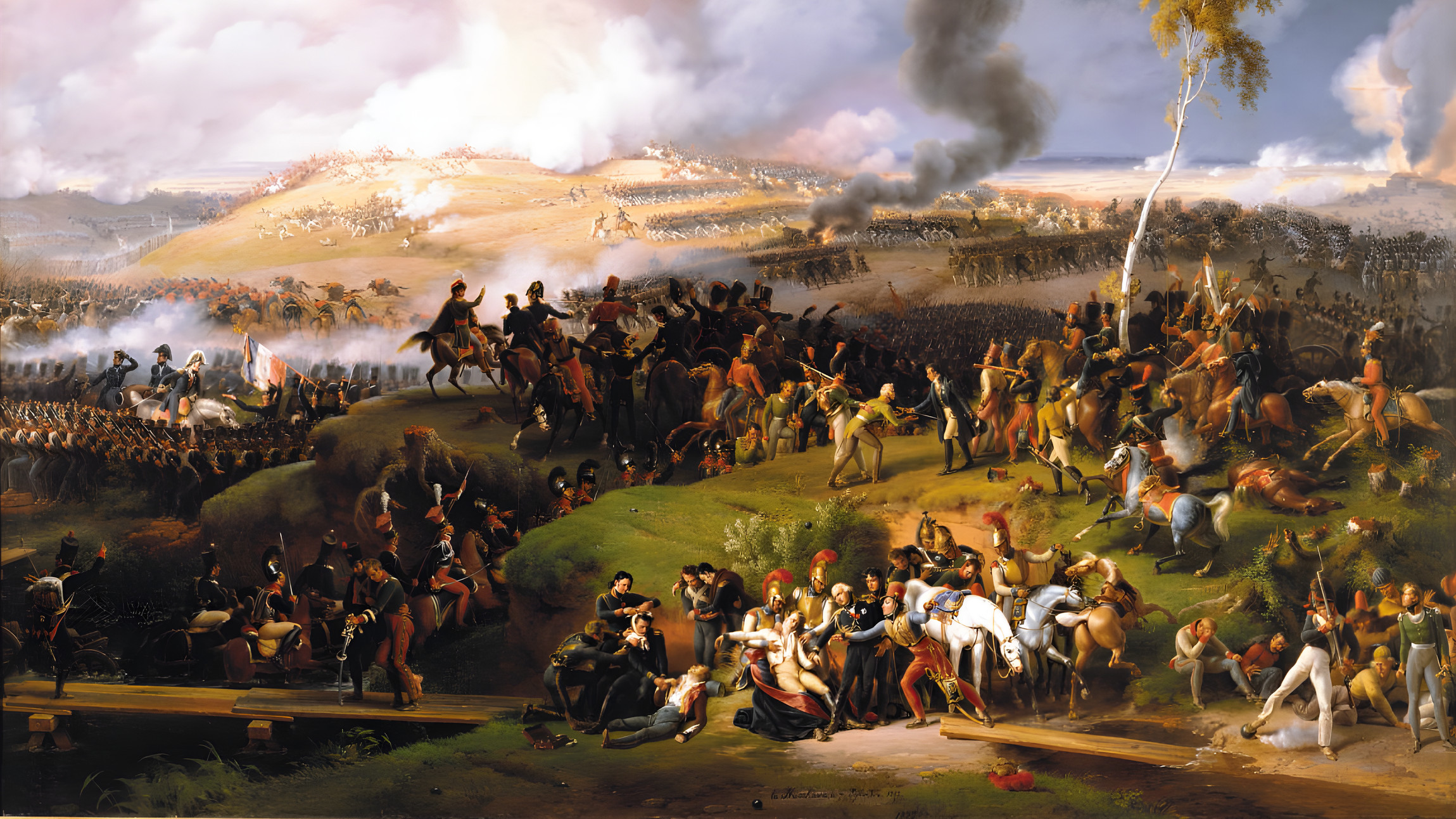
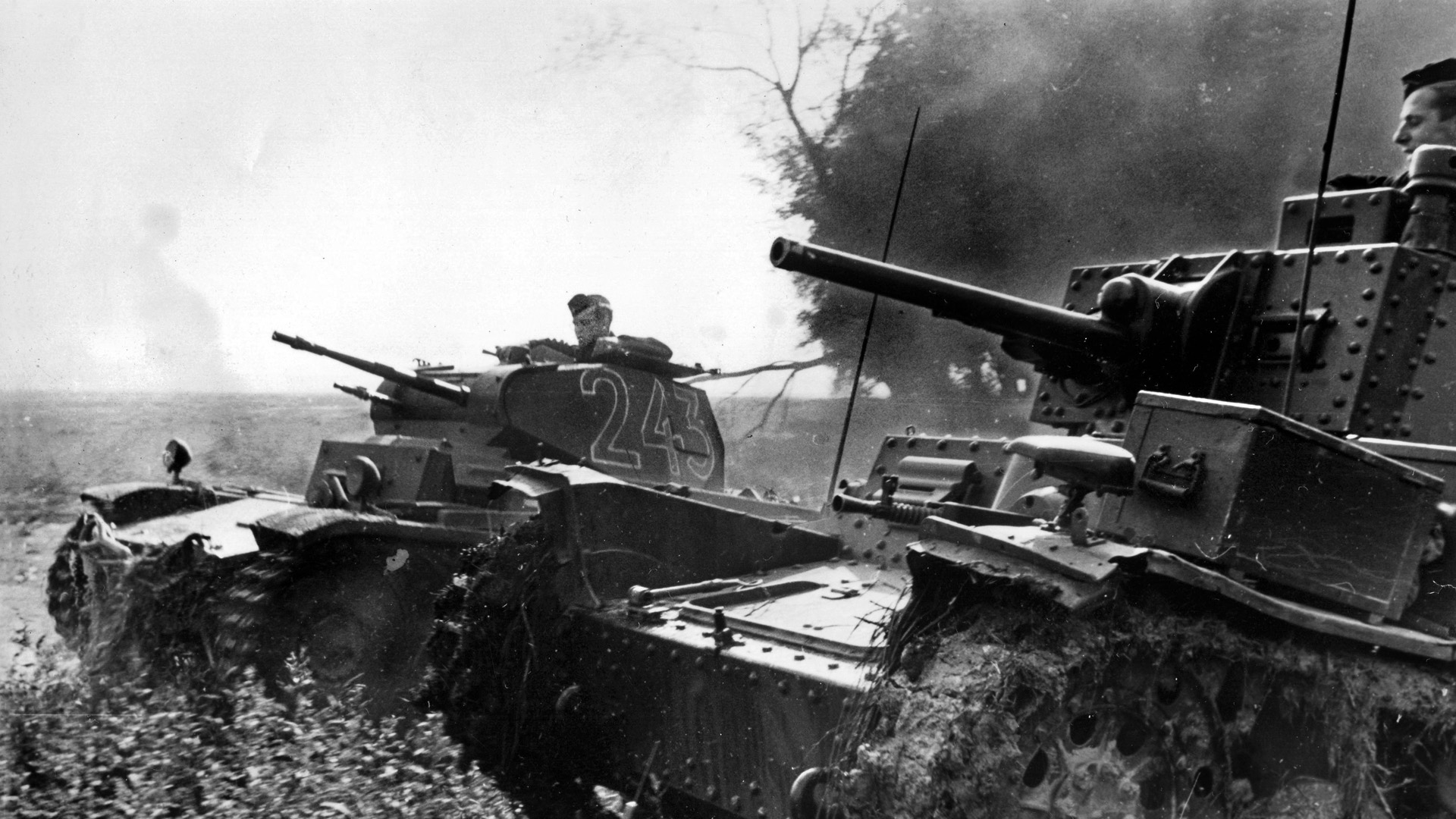
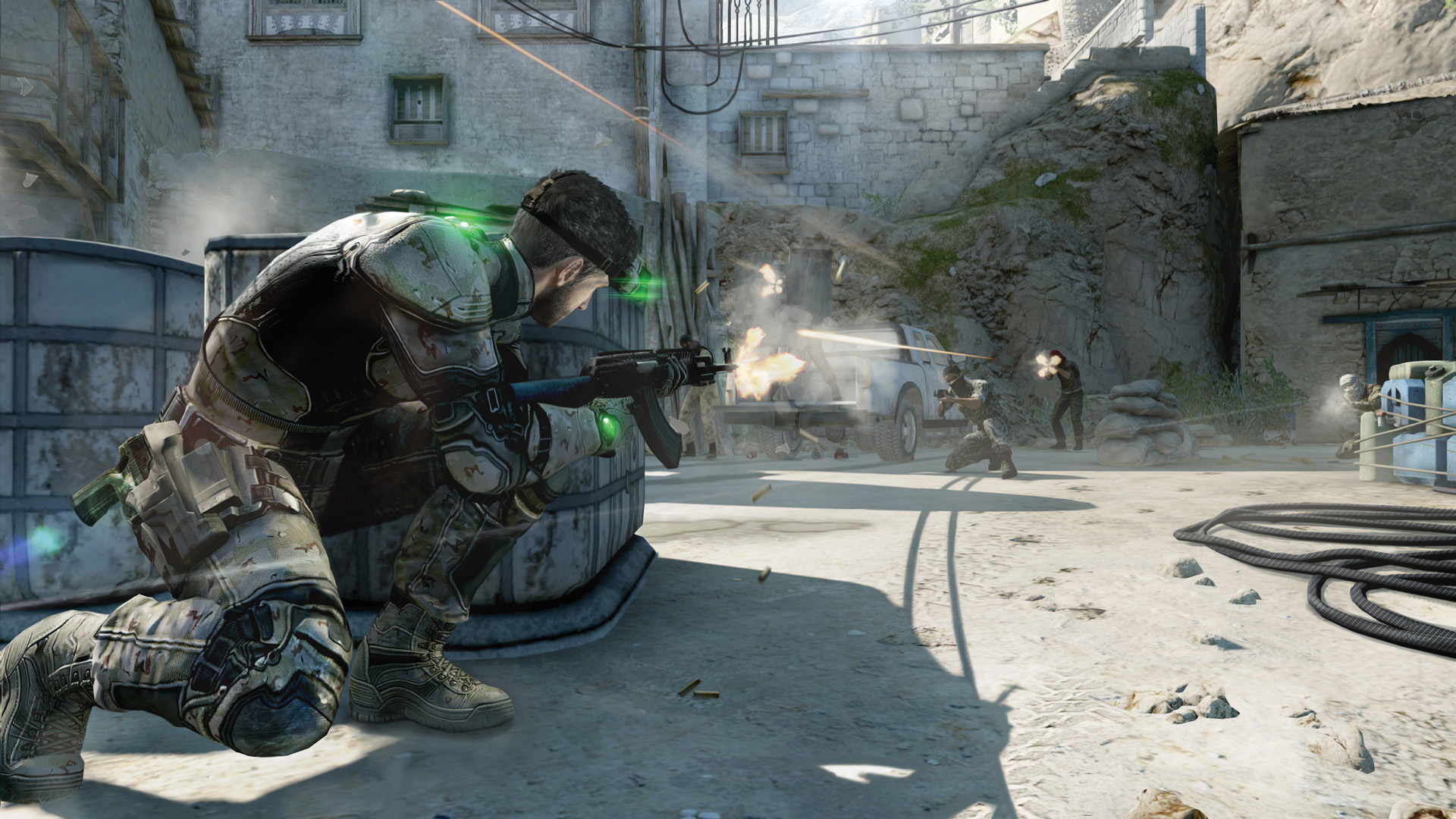
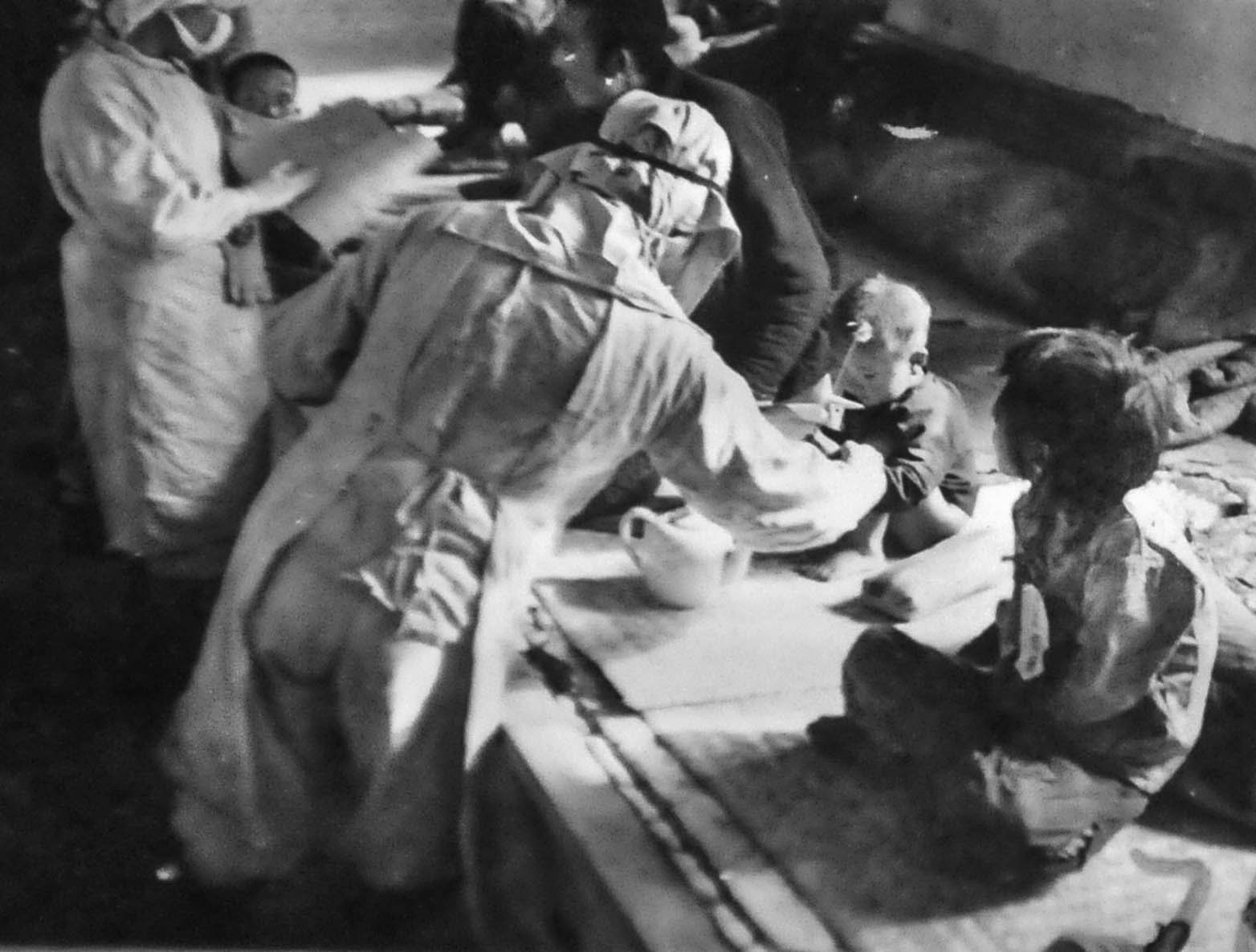
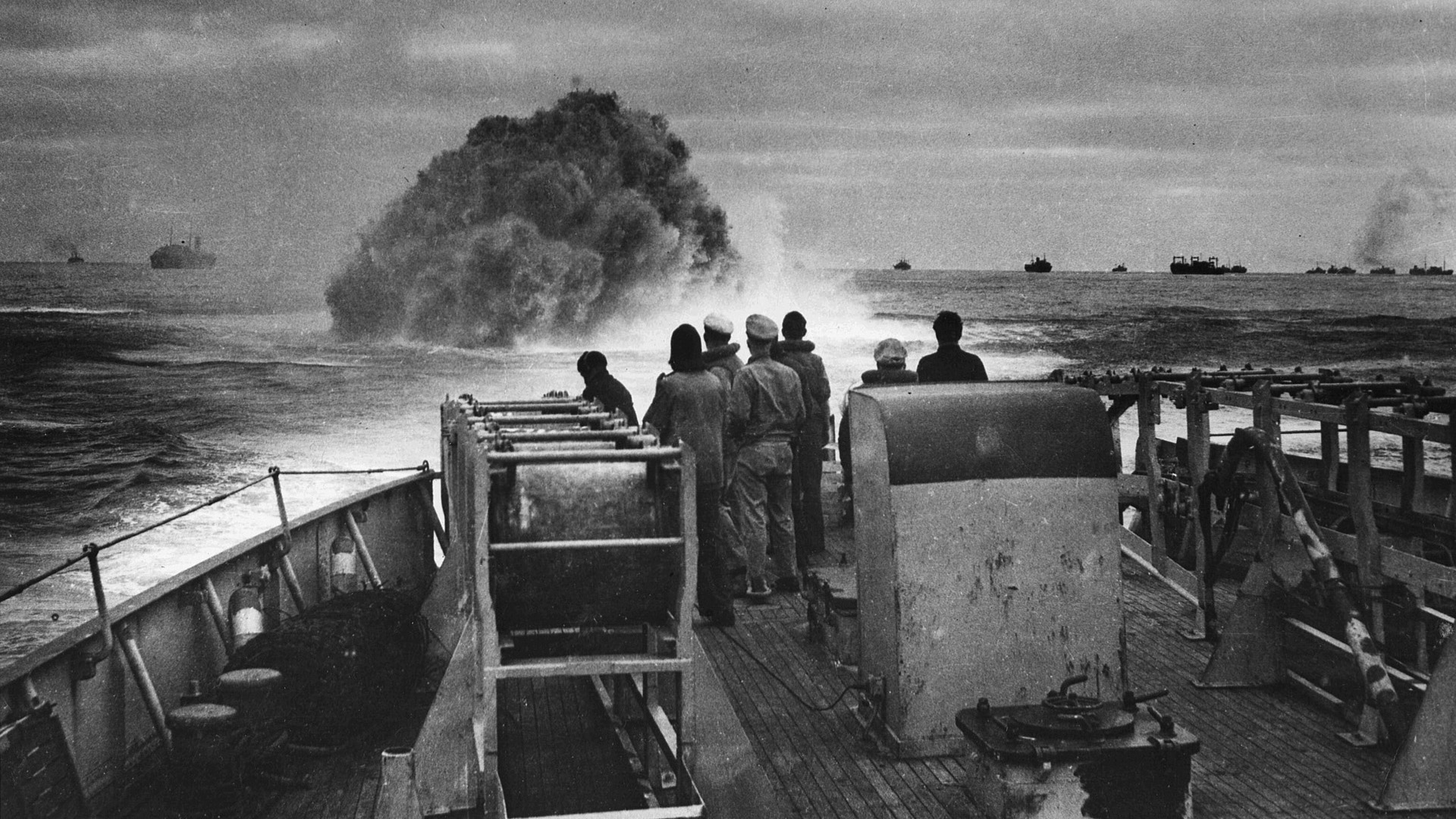
Join The Conversation
Comments
View All Comments